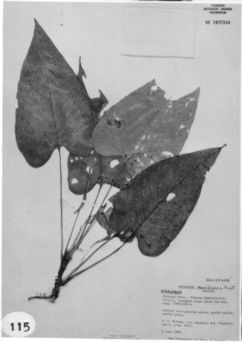




Anthurium pauciflorum Croat, sp. nov.
TYPE: Panama. Chiriquí: Fortuna Hydroelectric Project, forested slope above the Aoki camp, 1,200-1,400 m, Folsom et al. 8145 (MO 2807246, holotype).
Planta epiphytica; cataphyllum persistens in fibris tenuibus, linearibusque; petiolus anguste sulcatus, 10-21 cm longus; lamina ovata ad ovato-triangulata, modice membranacea, basi cordata, 15-21 cm longa, 8-10 cm lata; inflorescentia foliis breviora, erecta; pedunculus 4.5-8 cm longus; spatha subcoriacea, viridis, lanceolata, 2.7-3 cm longa, 5-7 mm lata; spadix lutens paucifloribus, 2-3 cm longus; baccae ignotae.
Epiphyte; stems 4-6 cm diam.; internodes elongate; roots thin; cataphylls ca. 4.5 cm long, drying tan, persisting around stem, weathering to fine longitudinal fibers.
LEAVES with petiole erect-spreading, 10-21 cm long, narrowly sulcate; geniculum ca. 1 cm long; blades ovate to ovate-triangular, moderately thin, long-acuminate at apex, lobed at base, 15-21 cm long, 8-10 cm wide, broadest at base or at point of petiole attachment; anterior lobe 13.7-20 cm long, margin straight to convex; posterior lobes 4÷6 cm long, from apex of sinus to outermost point; sinus parabolic to hippocrepiform, the apex rounded; both surfaces matte (dry), the lower surface markedly paler; midrib raised above and below (dry); basal veins 4÷5 pairs, the first and second free to the base, those remaining coalesced 0.7-1 cm, raised above and below (dry), yellow on lower surface; primary lateral veins 5-6 per side, departing midrib at 45-60° angle, prominulous above, raised below (dry), straight to weakly arching near collective vein; lesser veins conspicuous on drying; collective vein arising from the first or second basal vein, sometimes from one of the lower basal veins, prominulous above, raised below (dry).
INFLORESCENCE shorter than leaves, erect; peduncle 4.5-8 cm long, 1-2 mm diam.; spathe green, subcoriaceous, lanceolate, 2.7-3 cm long, 5-7 mm wide, strongly re-flexed, long-acuminate at apex; spadix yellow, cylindroid, rounded at apex, 2-3 cm long, ca. 3 mm diam. midway; flowers rhombic 2-2.4 mm long, 1.8-2 mm wide, the sides straight to weakly sigmoid; 3 flowers visible in the principal spiral, 5-6 flowers visible in the alternate spiral; tepals matte (dry), lateral tepals 0.7-0.8 mm wide, the inner margin straight to convex; pistils exserted; stigma linear, 0.4 mm long; not seen at anthesis.
INFRUCTESCENCE not seen. Fig. 115.
Anthurium pauciflorum is endemic to Panama in premontane rain forest at elevations of 1,200 to 1,400 m. The species has been collected only twice in the Fortuna Dam area.
It is a member of section Xialophyllium and is distinguished by its moderately thin, ovate-triangular to ovate, long-acuminate, cordate blades and by its somewhat elongate internodes but especially by its short inflorescence (shorter than leaves) with relatively few-flowered (thus the name) spirals on the spadix (usually three or fewer flowers visible per spiral).
The species may be confused with small-leaved plants of Anthurium caperatum, a species that occurs in the same area. The latter species differs, however, in having many more flowers per spiral (12-15).

Chiriquí: Fortuna Dam site, Folsom et al. 5566, 8145 (MO).